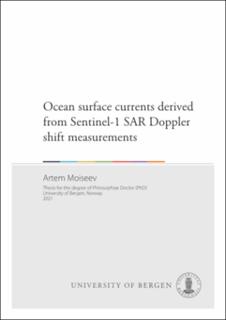| dc.contributor.author | Moiseev, Artem | |
| dc.date.accessioned | 2022-01-20T12:27:28Z | |
| dc.date.issued | 2021-05-20 | |
| dc.date.submitted | 2021-05-04T09:02:45.962Z | |
| dc.identifier | container/1c/88/fc/7f/1c88fc7f-06e6-4429-9002-8fa39b96f20d | |
| dc.identifier.isbn | 9788230861400 | |
| dc.identifier.isbn | 9788230841563 | |
| dc.identifier.uri | https://hdl.handle.net/11250/2838477 | |
| dc.description.abstract | Reliable information about ocean surface currents is crucial for operational oceanography, regulating weather development, and climate research (e.g., UN SDG 13). Upper-ocean currents are also key for monitoring life below water, including conservation of marine biodiversity at every trophic level (e.g., UN SDG 14). Locating upper ocean currents “with the right strength at the right place and time” is moreover critically needed to support the maritime transport sector, renewable marine energy, and maritime safety operations as well as for monitoring and tracking of marine pollution. In spite of this, upper ocean currents and their variability are mostly indirectly estimated and often without quantitative knowledge of uncertainties.
In this thesis, Sentinel-1 Synthetic Aperture Radar (SAR) based Doppler frequency shift observations are examined for the retrievals of ocean surface current velocity in the radar line-of-sight direction. In the first study (Paper 1), Sentinel-1 A/B Interferometric Wide (IW) data acquired along the northern part of the Norwegian coastal zone from October-November 2017 at a spatial resolution of 1.5 km are compared with independent in-situ data, ocean model fields, and coastal High-Frequency Radar observations. Although only a limited dataset was available, the findings and results reveal that the strength of the meandering Norwegian Coastal Current derived from the SAR Doppler frequency shift observations are consistent with observations. However, limitations are encountered due to insufficient calibration and lack of ability to properly partition the geophysical signals into wave and current contributions.
A novel approach for calibration of the attitude contribution to the Sentinel-1B Wave Mode (WV) Doppler frequency shift emerged for a test period in December 2017 - January 2018. Building on this calibrated dataset, an empirical model function (CDOP3S) for prediction of the sea state-induced contribution to the Doppler shift observations is developed for the global open ocean in Paper 2. The assessment against collocated surface drifter data are promising and suggest that the Sentinel-1B WV acquisitions can be used to study the equatorial ocean surface currents at a monthly timescale with a 20 km spatial resolution.
The calibrated dataset combined with the new geophysical model function developed in Paper 2 also allowed for the study (Paper 3) of ocean surface current retrievals from the high-resolution Sentinel-1B IW swath data acquired along the coastal zone on northern Norway. In this case, the geophysical model function had to be trained and adjusted for fetch limited coastal sea state conditions. The results demonstrate that the Sentinel-1B SAR-derived ocean surface currents significantly improved, compared to the findings reported in Paper 1.
Although the thesis builds on a limited period of observations, constrained by the availability of experimental attitude calibration, the results are all in all promising. Reprocessing of the full Sentinel-1 A/B SAR Doppler shift dataset using the novel attitude bias correction is therefore strongly recommended for further improvement of the empirical model function. Regular use of the Sentinel-1 A/B SAR for ocean surface current monitoring would thus be feasible, leading to advances in studies of upper ocean dynamics in support to the Copernicus Marine Environment Monitoring Service (CMEMS) program and the United Nations (UN) Decade of Ocean Sciences. | en_US |
| dc.language.iso | eng | en_US |
| dc.publisher | The University of Bergen | en_US |
| dc.relation.haspart | Paper I: Moiseev, A., Johnsen, H., Hansen, M. W., & Johannessen, J. A. (2020). Evaluation of radial ocean surface currents derived from Sentinel-1 IW Doppler shift using coastal radar and Lagrangian surface drifter observations. Journal of Geophysical Research: Oceans, 125, e2019JC015743. The article is available in the thesis. The article is also available at: <a href="https://doi.org/10.1029/2019JC015743" target="blank">https://doi.org/10.1029/2019JC015743</a> | en_US |
| dc.relation.haspart | Paper II: Moiseev, A., Johnsen, H., Johannessen, J. A., Collard, F., & Guitton, G. (2020). On removal of sea state contribution to Sentinel‐1 Doppler shift for retrieving Reliable Ocean surface current. Journal of Geophysical Research: Oceans, 125, e2020JC016288. The article is available in the thesis. The article is also available at: <a href="https://doi.org/10.1029/2020JC016288" target="blank">https://doi.org/10.1029/2020JC016288</a> | en_US |
| dc.relation.haspart | Paper III: Moiseev, A., Johannessen, J.A., Johnsen, H., (2020). Towards Retrieving Reliable Ocean Surface Currents in the Coastal Zone from the Sentinel-1 Doppler Shift Observations. Not available in BORA. | en_US |
| dc.rights | In copyright | |
| dc.rights.uri | http://rightsstatements.org/page/InC/1.0/ | |
| dc.title | Ocean surface currents derived from Sentinel-1 SAR Doppler shift measurements | en_US |
| dc.type | Doctoral thesis | en_US |
| dc.date.updated | 2021-05-04T09:02:45.962Z | |
| dc.rights.holder | Copyright the Author. All rights reserved | en_US |
| dc.contributor.orcid | https://orcid.org/0000-0002-6475-5088 | |
| dc.description.degree | Doktorgradsavhandling | |
| fs.unitcode | 12-44-0 | |
| dc.date.embargoenddate | 2021-11-20 | |
